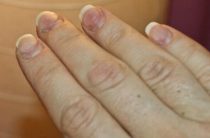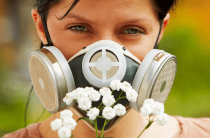Allergy is a disease that is the result of a defect in the immune system, expressed in an inadequate immune response to substances that are generally safe. Allergies can literally be anything. Substances that provoke an allergy in a patient are called allergies. Typical allergens are the substances to which you are most likely to be allergic. These include: substances contained in citrus fruits, chocolate, dust, pollen of some plants, pet hair.
Having an allergy to one allergen does not mean that it develops to other allergens. So, for example, the picture is quite typical when a patient with an allergy to the flowering of ragweed quite calmly endures the ingress of cat hair. Allergies are characterized by periods of seasonal exacerbation. So, for the beginning of the spring and the end of the autumn period, exacerbations caused by a violation of the immune system are characteristic. During the hot season, dry air causes increased dust formation, which is a common allergen. Allergics who suffer from sensitivity to plant pollen experience attacks during the flowering period.
What is an allergy?
Allergy is one of the most common diseases that humanity suffers from. To date, there is no cure directly for the causes of allergies . Allergy therapy is based on isolating the patient from contact with the allergen, as well as suppressing the immune response to the allergen.
To date, the incidence of allergies is progressing, which is facilitated by a number of factors :
- Increasing the level of personal hygiene to the point where the body loses interaction with many substances from the outside world. A modern person uses hygiene products much more often than even people in the last century. This is facilitated by both progress in the field of water supply and heating, as well as general cultural influence, as well as advertising of hygiene products.
- The formation of substances alien to the human body, which, penetrating inside, cause pathological immune reactions.
- In general, it is worth noting that one way or another, the causes of the spread of allergies should be sought in those phenomena that characterize the lifestyle of a modern person. For our ancestors, allergies were an extremely rare disease. It should be noted that the globalization of commodity exchange causes the appearance of those products that are not typical for the human diet of specific climatic conditions. As a result, those substances enter the body, for the normal metabolism of which it is simply not ready. This is characteristically seen in the example of the inhabitants of the Far North, who are allergic to citrus fruits indiscriminately.
- A feature of allergy is its complete individualization, which is expressed both in the absence of any possibility of transmitting this disease in any way, and a completely individual set of allergens for each patient. Often, unwanted dermatological manifestations of allergies (rash, ulceration, discoloration of the skin, etc.) cause aesthetic discomfort, which creates, in addition to the health problems inherent in the patient, also psychological problems. Children are especially prone to this, who, due to their specific appearance, which is often manifested as a result of allergic reactions, become objects of ridicule from other children.
- Another danger is the inability of modern medicine to rid the patient of allergies once and for all. This forces the patient to use drugs for life aimed at relieving her symptoms. Being medicines, these substances can also cause side effects, which creates additional difficulties for the patient. This is especially unpleasant for a patient with an allergy to substances from which he cannot be isolated. However, do not ignore allergies, as they can trigger other diseases.
Pseudoallergy
A separate word should be said about this pathology, which has similarities with allergies in clinical manifestations, but differs from it in the mechanism of appearance. Unlike an allergy, this reaction is not pathological. It is based on the action of certain substances on the metabolism of histamine, resulting in an increase in the concentration of this hormone, which causes the development of symptoms similar to allergies. The difference lies in the fact that these components, although they cause an increase in histamine activity, do not bind to antigens in a complex that provokes the development of allergies.
From the point of view of anatomy, pseudo-allergy is a normal reaction of the body. Usually, for its occurrence, a much larger amount of a provoking agent is required than for a true allergy. Symptomatically, there are no differences from allergies, from skin manifestations to anaphylactic shock. It is mainly provoked by drugs and food. For example, Roquefort cheese, when properly aged, contains a large amount of histamine, which, being a hormone formed from amino acid residues, is formed in protein products during bacterial influences. Naturally, the intake of a large amount of histamine in the body causes an increased activity of this hormone.
Canned fish and chocolate, as well as honey, contain pseudo-allergens and can cause allergen-like symptoms. In general, the therapeutic tactics in the treatment of false allergies is no different from the treatment of allergic diseases. To relieve symptoms, steroidal anti-inflammatory drugs, histamine blockers are also used, contact with the provocateur of symptoms is avoided. Tomatoes, strawberries, egg yolks are also among the foods that promote the release of histamine. This in no way means that these products are a mandatory factor contributing to the formation of a false allergy. However, they should not be consumed in obviously excessive amounts. It is also worth monitoring the reaction of people suffering from allergies, since pseudo-allergic reactions superimposed on allergic ones can significantly increase the negative manifestation of the underlying disease.
Also, pseudo-allergic reactions can be caused by internal factors.
Basically, such a picture develops as a result of the formation of intestinal bacteria that form the basis of the pathological intestinal flora. Another option for the development of pseudo-allergy is its appearance as part of complex manifestations of dysbacteriosis.
Dysbacteriosis is a violation of the reproduction of the intestinal microflora, which is normal for the physiology. Our body's own microbes, unlike those coming from outside, are not only not harmful, but also vital for the normal course of digestion processes. They also protect the intestinal walls from harmful microorganisms. The fact is that our native microflora is more adapted to a useful symbiotic existence. This enables it to successfully prevent the reproduction of harmful microbes, which are not able to withstand, provided our own bacteria normally multiply, in the struggle for food.
With dysbacteriosis, a lack of reproduction of healthy microorganisms develops, as a result of which harmful microorganisms are wedged into the work of the intestinal tract.
Unlike healthy microflora, pathological microflora is not friendly to our body. As a result of their vital activity, these microbes secrete substances that promote the release of histamine and lead to pseudo-allergies. Allergy symptoms
Allergy, among all diseases known to man, has the largest number of symptomatic manifestations, of varying severity and combination, in each case.
Varieties of manifestations of allergies:
Respiratory symptoms.
These are symptoms associated with the influence of immunity on the respiratory system of the body. They include: sneezing, allergic cough, nasal congestion, swelling of the airways. Basically, these manifestations are characteristic when an allergen enters through the respiratory tract, violations of the breathing process. Skin symptoms.
It would be erroneous to assume that this type of symptomatology is characteristic of allergic reactions that are caused by contact of the skin with an allergen. Skin manifestations can be formed when eating, for example, foods that cause allergies, while when these substances come into contact with the skin, allergic reactions do not occur. Skin manifestations include: changes in the color of the skin, the formation of a rash, acne, ulcers, blisters, abscesses, dry skin, itching. Conjunctivitis.
Most often, it develops when an allergen enters the eye and is characterized by increased lacrimation, redness of the skin of the eyes, and the formation of a conjunctive crust on the eyes. Swelling of the tongue, lungs, throat. The last two cases are of particular danger, since they cause the danger of suffocation, with extremely acute manifestations of these symptoms.
Complications of allergies
Even an allergy with minor manifestations causes unwanted changes in the body. One of the most characteristic complications of allergy is bronchial asthma, which is characterized by difficulty in breathing during attacks. Eczema and psoriasis are also variants of allergic complications. Allergy sufferers often suffer along the way from fatigue syndrome and are prone to irritability.
Anaphylactic shock is a syndrome that is one of the most dangerous consequences of allergic-inflammatory reactions. Often it is caused by food and drugs, as well as the bites of poisonous insects. In anaphylactic shock, skin inflammatory reactions spread rapidly, followed by laryngeal edema and vasospasm in the bronchi. All this causes breathing difficulties and is a deadly condition. First of all, to relieve spasm of the bronchial vessels, an injection of adrenaline is used, which has a vasodilating effect. Characteristic of this development of allergy symptoms is that this variant most of all threatens the inhabitants of the most economically developed regions.
Quincke's edema is a characteristic increase in various organs, as a result of allergic swelling. The most dangerous is the condition in which the larynx swells, which causes difficulty in breathing. Such a condition requires the use of immediate therapeutic measures, followed by hospitalization of the patient.
Causes of allergies
- genetic factors. Allergy is a disease that is inherited. Although this is not the only cause of allergies, nevertheless, the palm in this matter belongs to heredity. In general, allergies are transmitted from the mother, the allergy is transmitted to a lesser extent through the male line than through the female.
- Transferred diseases of an infectious nature. Basically, a similar reason for the development of allergies is relevant in children. This is due to the fact that the immune system in childhood is at the stage of formation. Adults are less susceptible to this variant of the development of allergies, since their body has already formed and is much less susceptible to changes.
- Unhealthy personal hygiene. Overly frequent use of hygiene products, sterile cleanliness in the house create conditions in which the immune system loses its ability to function normally. This is due to the absence of factors in conditions of excessive sterility that stimulate its proper operation.
- Frequent contact of modern man with aggressive substances of the chemical and food industries of unnatural origin. At the moment, this is only a hypothesis, however, it seems quite obvious that substances atypical for humans can cause various disorders of the body, including allergic reactions.
- Incorrect use of drugs. In addition, modern man uses too many drugs. This is due to advertising, which aims not to introduce a person to effective methods of treating a disease, but to increase profits. As a result, due to the frequent and uncontrolled use of drugs, the body fails, manifested in particular as an allergy. Especially, this applies to the use of painkillers, various creams and ointments, as well as drugs to relieve symptoms of a cold. It is worth remembering that drugs that cause the removal of symptoms of a cold or headache do not eliminate the cause of the disease, but even more disrupt the body. Their use should take place according to the appointment of a specialist and in no case in isolation from the treatment of the cause of the disease.
Allergy diagnostics
Intradermal tests
This type of examination is the easiest way to detect the presence of hypersensitivity to a particular antigen. This diagnostic method is the introduction of a minimal amount of the allergen under the skin, either by injection or through small, specially made incisions. The sensitivity of the patient to the allergen is determined by diagnosing the condition of the skin at the injection site. In patients with developed allergies, this procedure causes various characteristic lesions at the site of the cut.
Antigen level measurements
During an allergic reaction, there is an increase in the level of specific antibodies that occurs in response to the action of the allergen. Diagnosis occurs first by test groups of allergens, then the selected group is localized in order to identify a specific allergen or several.
Allergy treatment
Allergy treatment is characterized by a wide range of drugs used because of the possibility of interrupting allergic reactions at several stages of its occurrence. For allergies, the following classes of drugs are used:
Antihistamines
Histamine is one of the biologically active substances of the human body that cause allergic reactions: inflammatory processes and edematous conditions, as well as skin itching and peeling. Blockers of histamine receptors, due to which inhibition of allergic reactions caused by histamine occurs. It would not be superfluous to recall the same therapy with small doses of histamine for allergies and bronchial asthma, which helps to reduce the body's response to the action of this hormone.
These drugs have a depressant effect on the nervous system, therefore, during their use, driving and other actions that require high accuracy and quick response are highly discouraged.
There are three generations of antihistamines:
- First-generation drugs are the first antihistamine class anti-allergy drugs to hit the market. They are characterized by a wide range of side effects: disorders of the gastrointestinal tract, decreased reaction speed and concentration, attacks of heart palpitations, drowsiness. To date, they are used less and less, due to the high incidence of side effects and reduced effectiveness after administration.
- Second-generation drugs differ, do not affect daily activity and can be used throughout the day, since they do not cause inhibition of the reaction. However, they have a certain negative effect on the heart, limiting the supply of potassium to the heart muscle.
- Third-generation drugs are similar in action to second-generation drugs, but are safe for the heart. To date, these drugs are the safest means of suppressing the activity of histamine.
Anti-inflammatory drugs of steroid structure
Cortisol is a steroid hormone that has numerous important functions in the body, in particular, relieves swelling and inflammation, removes skin manifestations of allergies . This class of anti-inflammatory drugs consists of synthetic derivatives of cortisol, as well as other substances that can act on the receptors of this hormone and cause the same effects.
These drugs are available both in injection form and in the form of ointments, creams and sprays for application to the skin or for injection into the sinus.
Glucocorticoid-based drugs have a high degree of side effects, so their use for allergies is under medical supervision and is used only in the short term (5-7 days), their high efficiency leads to a rapid removal of symptoms, after which treatment continues with lighter drugs. Typical side effects include: potassium deficiency syndrome in the body, heart failure, decreased strength of bone and connective tissue, which leads to bone fragility and trauma to the articular-ligamentous apparatus, protein catabolism, decreased immune function, disorders of the gastrointestinal tract, muscle weakness .
For external use of steroid ointments and sprays, a local violation of skin immunity is characteristic, which can provoke the formation of seborrhea, acne, and the appearance of various skin infections.
Sorbent preparations
This is a group of substances that are able to bind to other substances in the gastrointestinal tract, facilitating their elimination. Basically, their use is justified for food allergies. By binding to allergens that have entered the gastrointestinal tract, sorbing agents bind to allergen molecules and contribute to their speedy elimination. Due to this, they do not have time to enter the general circulation and cause an allergic reaction.
It should be noted that sorbents also disrupt the absorption of nutrients, vitamins and drugs, therefore, they should be used with great care.
Vitamins and minerals
These nutrients are indispensable components of nutrition and are vital for the normal functioning of the body.
The same is true for the normal functioning of the immune system. Please note that most of the drugs used in the treatment of allergic reactions are potent drugs with their own side effects. Therefore, self-treatment of allergic symptoms is strictly prohibited! Treatment can only be prescribed by appropriate specialists after diagnostic procedures, a detailed study of the medical history and examination of the current state of health.
Decreased sensitivity of the immune system
This method consists in systematic vaccination with a certain amount of antigens. This is necessary for the development of the body's ability to biologically inactivate them. This method involves long-term therapy, taking place under constant medical supervision.
Allergy in children
Children often suffer from allergic reactions, due to the fact that their immunity is not formed and the body as a whole is more vulnerable to various substances that the adult body can easily cope with.
Allergy manifestations in childhood are often caused by malnutrition. And of great importance is the observance of the correct diet by the nursing mother during breastfeeding. Mothers need to exclude foods from the diet - allergens: honey, pineapples, citrus fruits, shrimp, mussels, avocados, chocolate. In general, it is worth abandoning unnatural foods in favor of natural, seasonal and baby-safe foods. Please note that food allergies are much less likely to occur on local products, since the human body has adapted to this for generations. Obviously, for a resident of Asian countries, for example, an orange is not a typical allergen.
Allergic reactions are often characterized by skin manifestations, with areas of redness, peeling and itching. Ointments and other external agents for diathesis should be used in small quantities and with caution, since the skin of the baby is extremely vulnerable.
allergies in pregnant women
Pregnancy is a condition characterized by numerous hormonal changes within the body. The course of pregnancy can provoke an exacerbation of allergic reactions, as well as provoke the development of allergies in the body, even if no allergic reactions have been observed before. Due to the special situation of the patient, careful selection of drugs is recommended. Drugs with teratogenic activity are completely prohibited, since in this case the effect on the fetus that these drugs can have is unacceptable. Treatment is selected with particular care, using the minimum dosage. First of all, it is necessary to ensure complete isolation from the provoking allergen.
Allergy to insect stings
This type of allergy is one of its most dangerous varieties. Often, insect bites provoke the lightning-fast development of acute allergic manifestations. Not only the patients themselves, but also the relatives of the patient should be familiar with the symptoms and methods of combating this phenomenon, since the severe development of allergic reactions may well lead to the fact that the patient will not be able to help himself on his own. The situation is complicated by the fact that insects are extremely common creatures and it is impossible to protect yourself from them by 100%.
Often, after insect bites, people with allergic reactions develop anaphylactic shock. This condition implies a potential danger to the life of the patient, therefore, persons suffering from this type of allergic reactions must necessarily have a special kit to deal with anaphylactic shock and be able to use it. It is also necessary to familiarize loved ones with this so that they can help in the event of a rapid onset of symptoms.
Prevention against allergies
First, the most important thing for you is to avoid contact with the allergen. If the allergen is of an unknown nature, consult a doctor to diagnose the cause of allergic reactions and eliminate the provoking factor. Try to use foods that are not typical for your climate with caution, as an organism that is not familiar with them can react to them with allergic reactions. Spend more time outdoors, strengthen your immune system with an active lifestyle and hardening your body, take vitamins and minerals in the required amount.
Particular attention should be paid to your diet, which should consist of high-quality natural products. Refrain from the use of substances containing flavorings and preservatives.
Carefully monitor personal hygiene, but keep a reasonable measure in this matter. Keep your work area or home well ventilated. Remember that excessive use of hygiene measures provokes the suppression of the normal function of the immune system, and can also provoke the emergence of new types of allergies. In clothing and personal care products, give preference to things and products with a natural composition.
Remember that products such as alcohol and tobacco, having a systematic negative effect on our body, can both provoke the development of allergies and aggravate its course. Allergic people, in principle, need to refrain from using these substances, which will not be useful for a healthy person.















